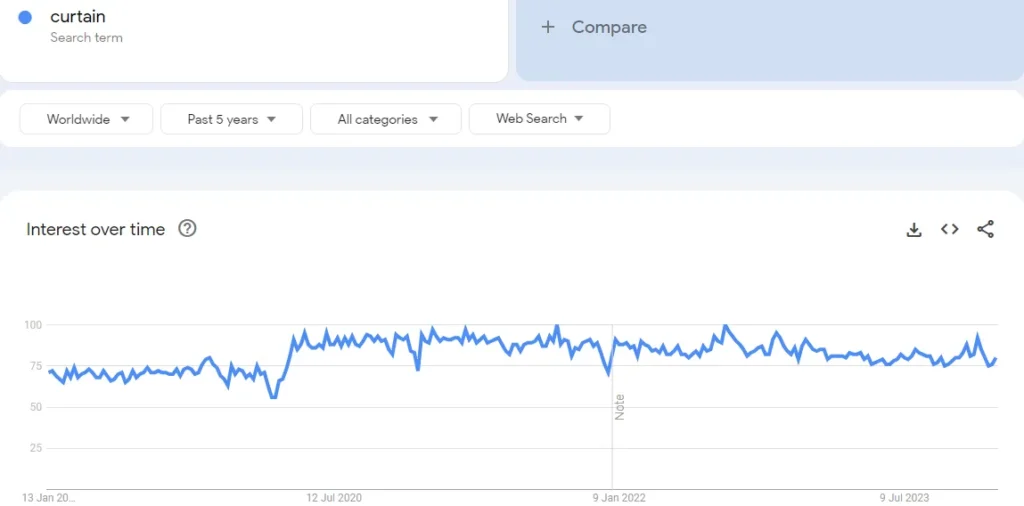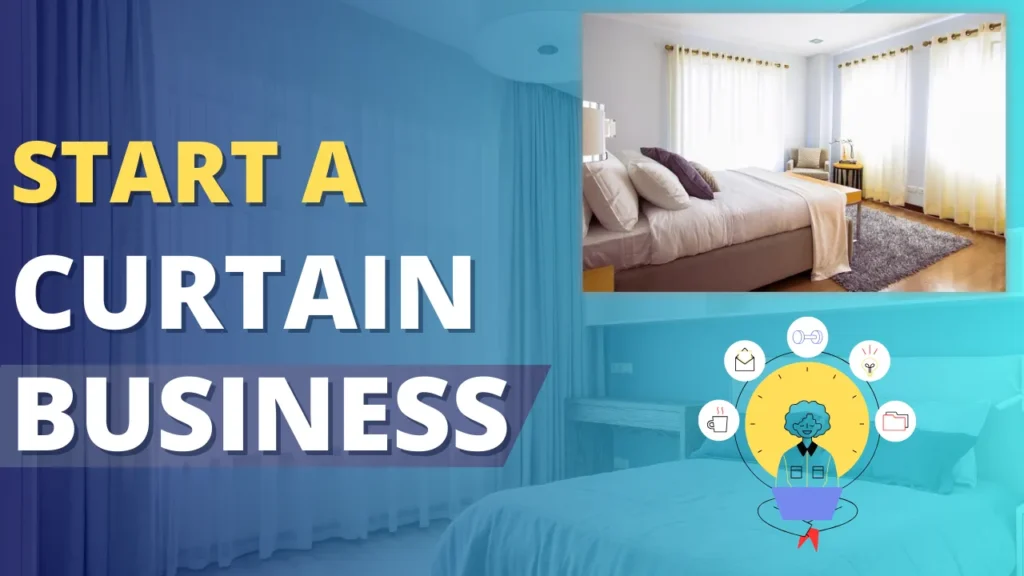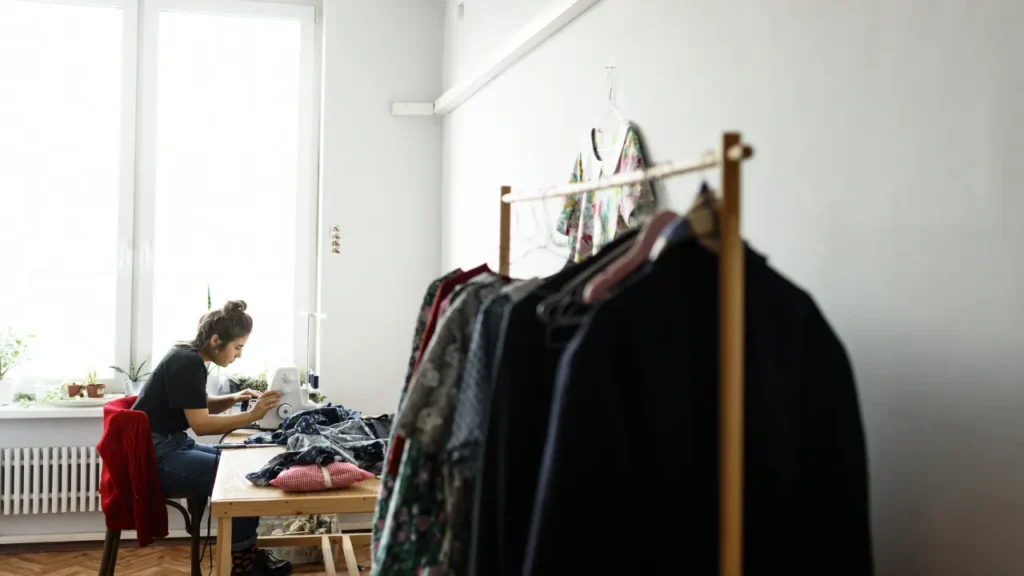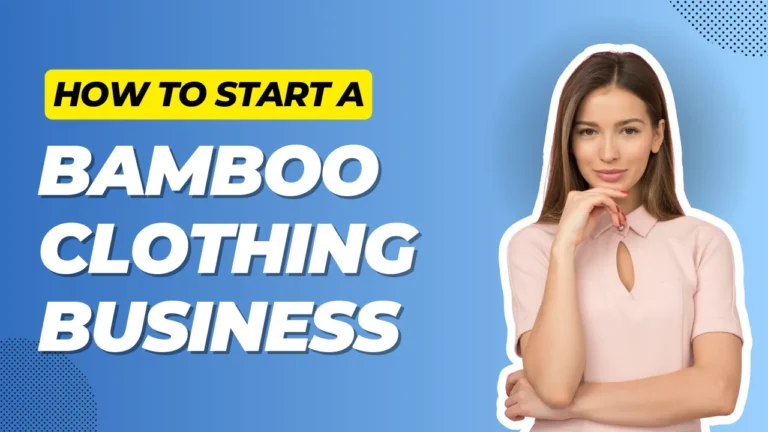Are you looking for a guide on how to start a curtain business?
You have chosen the right place.
Curtains are a staple of the interior design of our houses, and we use them for privacy, light control, style, and decoration; if you are wondering about starting from scratch, then our blog post is for you.
Starting a curtain business can be a lucrative opportunity.
But before you dive into the business, there are a few things you need to consider.
We have covered all the steps that are helpful for a beginner, from market research, planning, investment, equipment and raw materials, production, marketing, and selling everything.
If you have decided to start this venture, then this article will be most valuable.
Is curtain business profitable?
Yes, starting a business selling curtain is a profitable and growing opportunity.
Determining the profitability of this business may depend on various factors such as market demand, competition, seasonal preference, target location, pricing strategies, and operational cost.
Evaluate the profitability and develop a solid foundational business plan for your successful business, which will provide you with the right path to grow along the way.
When deciding to start a curtain business, analyze both the upside and downside.
Pros
- Good profit margins
- Low overhead costs
- Demand is high
- Customizable products
- Diverse customer base
- Profit from online sales
- Local manufacturing facilities
- Interior design trends
Cons
- Competitive market
- Inventory management
- Physical space requirements
- Technical skills
- Seasonality demand
Here, you can see in the graph how the curtains search trend is steadily increasing, and it has a good trend, no seasonal fluctuation, and economic downtime, which is a positive sign for profitability.

Curtains trends, demand, and growth:
Curtains are used everywhere. Usually, they are hung on doors and windows. It is needed in homes, offices, schools, medical, hotels, and everywhere.
The curtains and blinds market is set to reach a revenue of approximately $38.92 billion by 2023, and it is projected to exhibit an annual growth rate of 5.60% from 2023 to 2028.
On a global scale, the United States stands out as the largest contributor to this market, with an estimated revenue of $9,391.00 million in 2023. (Source – Statista)
How to start a curtain business?

Follow the steps to start your successful curtain selling line; we have described all those steps in detail. Read carefully and follow the step-by-step process.
1. Market research and planning
Research is the process of assessing the market demand, competition, and target customer base, so for curtain business, you need to conduct market research.
Research the market to understand your customer base and competition; as a newbie, it can be difficult for you to analyze the market, but don’t worry; here we mention some steps to find potential market-related data for your business.
Use online resources and tools to check the market growth, trends, and demand.
Google Trends is also a useful tool for analyzing market trends.
As well you can also identify trending and most-selling blanket types at online marketplaces (Amazon, eBay, Etsy, AliExpres, etc.). Visit their best-seller pages to find the high-selling products and trending teams.
Knowing market competition
Understanding the market competition, analyzing competitors, pricing models, etc.
Identifying potential competitors for a certain business, answer a simple question: “Who sells curtains?” Many businesses and individuals sell curtains, and they are making a good (part-time or full-time income source).
- Curtain retailers
- Online retailers
- Home improvement stores
- Fabric stores
- Discount stores
- Special curtain stores
- Curtain manufacturers
- Many individual business owners (who sell online or offline)
Manufacturers: Also, many companies produce curtains in large quantities to sell them for profit. Retailers, wholesalers, stores, and individual bulk buyers are their main target customers, and they make a huge amount of money from their manufacturing line.
These are the primary competitors in your line. Hopefully, you understand.
Researching about product: different types of curtain, raw material, making process, use, pricing, packaging, and distribution methods.
Identify your target customer.
When starting a curtain business, the first step is identifying the potential customer from the market.
Identify who is your target market or customer, potential, and demand.
Once you have found your target audience, the next step is to develop a business plan according to your target market or audience.
Who is your target customer?
Identify your target customer and hungry buyer, and for that, do more and more research.
First of all, identify where the curtains are mostly used.
Here are some examples:
- Homes
- Offices
- Hotels
- Restaurants
- Theatres
- Shops
- Museums
- Trains and aeroplanes
- Outdoor areas
Conduct demographic research (age, gender, income, occupation, location, lifestyle, interests, and fashion demand).
Develop a curtain business plan.

Home improvement is a growing, high-demanding, and trending industry. With proper research and planning, anyone can establish a successful business.
To get started, write a business plan that helps to achieve your goal strategically; also, a plan provides a roadmap to work on the right path.
For a curtain business, here are a few points that you can include when writing a business plan: a well-thought-out business plan will work as a GPS for your success.
- Product plan: In a business summary, write about creating high-quality curtains, reliable products according to the target customer, also your additional features to compete with the existing competitors.
- Research: Creating a strong identity for reaching out to worldwide customers. It also requires proper research, a good understanding of the target market, competition, and customer preferences, as well as you need to know the current market trends.
- Business Description: Find your unique selling proposition, product type, target customer, and other information related to curtain business, that helps to define your goals as well as your business.
- Business model: The plan must include your business model type. For starting a curtain business, you can start with (manufacturing, wholesale, e-commerce store, physical store, etc).
- Marketing plan: The marketing plan should include both free and paid marketing ideas that help to grow your venture initially, include some points about brand awareness, and focus on local marketing and digital marketing strategy.
- Financial plan: Write on financial planning, calculate startup cost, prepare a budget, profit statement, investment planning, and the best source to arrange funds.
- Business setup: Good supplier connection, space selection, shop setup (online or offline), equipment and raw material (if manufacturing), workforce, legal requirements, marketing, selling, etc).
To become a successful entrepreneur, you need a proper guide and information and also need different business skills like team management, finance management, marketing skills, etc.
Require a good marketing strategy with high-quality products to stand out from the market competition and target a large customer base.
2. What is the best idea to start
Set a goal to work with a passion for creating a curtain brand in the market – no matter manufacturing, designing, or creating an online store.
Before you plan to start a curtain/drapery business, the first and most essential steps that need to be considered a profitable business model.
Selling curtains and making a profitable business require proper research and planning. Also, a good understanding of different business ideas will help you choose the right option.
You can run in many ways, both online and offline.
All the steps and considerations we have described through steps you will get to learn by reading this blog post, so don’t miss any points.
Here are the differences between the business model and ideas:
Manufacturing:
Many businesses focus on manufacturing or designing curtains with their sewing skills and creating high-quality patterns for selling.
The main benefit of a manufacturing line is you can choose a wide range of materials, patterns, and designs; the idea offers endless possibilities for creating the perfect product.
Design, manufacture, and sell the curtains by creating your own retail or online stores; also, you can sell in bulk to wholesale retailers.
Requires significantly more investment to create a manufacturing setup – requires a dedicated space, raw material, equipment or tools, packaging supplies, and a designing or sewing staff.
Offline store:
Most businesses focus on starting a retail curtain business because it is easy to start, has a simple model, has a low overhead cost, and has a high-profit margin.
For opening a retail store – selecting the right target location where there is more foot traffic and customer demand, opening a retail store, marketing, attracting potential customers, and then selling.
Purchase ready-made curtains from manufacturers or wholesalers to sell them directly to consumers through a physical store.
Online store:

Another popular business idea is to focus on selling curtains online; the idea is the most profitable, proven, and trending in the current scenario.
Everyone has a mobile phone and internet connection, and people buy all types of gadgets, products, and clothing items online.
Many online e-commerce platforms are popular, such as Amazon, eBay, Etsy, and Facebook marketplace, are popular for online clothing businesses.
However, the process of selling online and offline is not different (choosing a workspace, planning, researching, buying supplies, marketing, and branding), but a few steps may be different.
Still, it requires different types of skills to operate (for example – online selling requires proper marketing skills, online store setup, pricing, packaging, and delivery).
Starting a Curtain Business: Online vs. Offline Store:
| Feature | Online Store | Offline Store |
|---|---|---|
| Startup costs | Low cost: Need to build an online website or e-commerce store (domain and hosting), as well as inventory setup | Higher cost: Rent, utilities, insurance, staff payroll, furniture, fixtures, inventory |
| Ongoing costs | Low overhead cost | Higher: Rent, utilities, and ongoing expenses. |
| Reach and Customer Base | Larger potential reach, global audience | Mostly local customers |
| Marketing | Focus on digital marketing: SEO, social media, paid advertising | Utilize local marketing: flyers, print ads, community events |
| Sales and Revenue | Potential for higher sales volume due to wider reach | Depending on foot traffic, the sales number can increase |
| Customer Experience | No interaction: only product descriptions, reviews, chatbots | Face-to-face conversation, negotiation, and overall good customer experience |
| Return and Exchange Policy | Easy returns online | Easy, if the customer lives near the shop |
| Scale potential | To scale the service, add products, hire team members, and expand the shipping zones | Challenging to scale up: need more physical space, staff |
| Flexibility | Work from anywhere with an internet connection | Long hours to work physically, whole day |
| Brand building | Focus on website design, storytelling, product quality, shipping, and digital branding. | A physical store atmosphere can contribute to creating a brand identity. |
You should consider those ideas focusing on your target market, depending on planning, growth plan, resources, budget, profitability, location, and flexibility (online or offline).
3. Decide a business location.

Finding the right workspace to set up your business and to increase work productivity.
Consider factors such as location, size, storage capacity, and security.
A good workspace is most vital, for example:
- Business focus: Sewing & fabrication, retail & alterations, online sales.
- Inventory: More fabrics = more storage space.
- Showroom: Needed for client interaction.
- Employees: Each requires workspace and equipment.
Start from basic, focusing on future growth.
If retail shop (space for storing, storefront, shopping setup, etc).
A suitable workspace will provide a conducive environment for designing, manufacturing, storing, and showcasing your curtains while also meeting the needs of your customers.
If you want to start the business of curtain manufacturing, then you may need more space as a manufacturing workspace.
When choosing a location, here are some important tips:
- Location: Accessibility, visibility, and proximity to suppliers and customers.
- Space size: Sufficient room for production, storage, and display.
- Cost: Affordability of rent, utilities, and maintenance.
- Infrastructure: Adequate electrical, plumbing, and ventilation systems.
- Safety: Compliance with local codes and security measures.
- Accessibility: Easy access for deliveries and customers.
- Zoning regulations: Ensure the space is zoned for your business type.
- Parking: Sufficient parking for employees and customers.
- Amenities: Nearby amenities like restaurants and public transportation.
You can set your workspace near:
- Near residential areas.
- Close to interior design or home improvement stores.
- In a commercial or retail district.
- Accessible and visible to potential customers.
- In a well-trafficked area.
4. Sourcing and production

Making curtains requires some necessary equipment, machinery, and raw materials used in the production and customization of curtains.
You can purchase them from fabric stores or online; also, check out Amazon and other online stores to buy those supplies at the best price.
These items are required for both small-scale crafters and large-scale curtain manufacturers.
Here is a list of common curtain-making equipment and supplies:
- Sewing Machine
- Fabric: Cotton, linen, silk, or polyester in different colors and patterns.
- Measuring Tools: Measuring tape, a straight-edge ruler, and a square ruler.
- Cutting Tools: Scissors, rotary cutters, and a cutting mat.
- Thread: Purchase different colors of thread.
- Needles and Pins: Fabrics require different needles and pins for sewing.
- Work table: Stable surface for measuring, cutting, and sewing.
- Storage: Shelves, bins, or cabinets to store your fabric, supplies, and finished products.
- Business tools: Computer, printer, Pens, Notebook, Time Management or Business management software and accounting software to manage, etc.
Before buying anything, join in training to understand the basics and learn the skills.
Learn how to make curtains: Blog posts (Visit and read the Wikihow steps guide)
Learn the skills

Develop your skill set to improve productivity, performance, and overall growth. Starting a curtain business – requires skills such as:
- Technical skills: Sewing, measuring and installations, fabric knowledge, match for measuring lengths.
- Creative skills: Interior design, problem-solving, marketing, and sales.
- Other skills: Communication, time management, customer service, customer service, computer skills, business management, etc.
Start from understanding the fundamentals, with practice and day-by-day operation; skills will improve with time.
Work both hard work and smart work, and follow your passion, interest, and creativity.
If you are not good at sewing skills, then hire skilled staff and manage another task yourself, such as marketing, pattern designing, or shipping.
5. Come up with a business name
We can assist you how in choosing a name for your business that communicates all about your products. However, research your own to find the best name yourself.
Basic things to keep in mind, such as finding an easy-to-sell, simple, unique, creative, product-related name for your brand.
For building a strong online presence, brand identity, and a good reputation in the market, a business name plays a primary in fulfilling this subject.
- A unique name and logo will help in the brand-building of your business.
- Avoid using (numbers, underscores, hyphens, and symbols) in a name.
- A domain should be available with the name (for creating a website).
- Use the business name generator tool, which will save time and effort.
- Research and follow the legal rules (don’t use copyrighted names).
Depending on your location, focus on including location; for example, if the location is California, then name your brand, such as (Cali Comforts, Cali Cozy Interiors, California Couture Draperies, etc.).
Curtain business name ideas:
Consider the names for only ideas, and do your research to find a more attractive, brandable, unique, and user-friendly name.
With those factors in mind, here are some possible names for your curtain business:
- Fabric Focus
- Dream Curtains
- Gracious Curtains
- Curtain Couture
- Artful Curtains
- Curtain Connection
- Curtain Express
- Curtain Factory
- Anything Curtains
- Curtain Plus
- Custom Curtains
- The Curtain King
- Curtain Crazy
Once gathering some name ideas, choose the best one that is suitable according to your needs.
Register a domain (.com) for a web online presence; the domain is required when making a website, so check the domain availability first and register it.
Namecheap or Godaddy are more popular for resisting domains.
6. Fulfill the legal documentation
You need to make sure you have all the licenses and permits; depending on where you start the business, you may also need a permit to sell your curtain.
It depends on your state and local authority where you want to operate the business.
- Choose your business structure (sole proprietorship, partnership, LLC, or corporation).
- Registration: follow your state and local registration requirements.
- Business license: Check local and state regulations for the type of license needed.
- Permits: obtain the necessary permits, such as a zoning permit or a building permit.
- Insurance: get insurance to protect your business from potential liabilities.
- Bank account: open a bank account for your business.
- Understand and comply with tax regulations.
Research is important before you apply for those.
Make sure – to consult your local authorities because the legal needs are different from location to location; also, a legal advisor or attorney can help you in this step, which is important for safe documentation.
7. Financing your startup
Before planning for financing, first of all, estimate the initial startup budget.
Startup cost in curtain business depends on many factors, including your business model, size of the project, location, staffing, online presence, marketing, website maintenance, and other related expenses.
Without knowing the requirements, it isn’t easy to estimate the actual budget.
Next, find funding sources to arrange funds for your business, research different options, and find the suitable one.
Once you calculate, then plan to arrange funds.
- Start small: Use personal savings or pre-sell curtains.
- Seek loans: Consider SBA loans and small business loans from banks.
You can find more options, but what is important is to have a strong idea, goal, and business plan.
8. Marketing and sales

Marketing and promotion are the primary parts of business success and growth, so to create a good customer base for Curtain Line, you need the right marketing strategy.
How to promote curtains?
- Create a brand identity
- Invest in photography
- Build an online presence
- Explore offline marketing
- Develop pricing strategy
Promote your curtain business through different marketing channels.
Follow the free marketing methods to reach potential customers.
- Social media marketing: Promote on Facebook, Instagram and Twitter.
- Content Marketing: Create valuable blogs and videos and optimize for SEO.
- SEO: Optimize website, use keywords, on/off-page SEO.
- PPC Ads: Run targeted ads, manage budget, optimize.
- Influencers: Partner authentically with specific influencers.
- Videos: Create engaging videos and use different platforms.
- Local SEO: Optimize for local searches and listings (listing on Google My Business).
Create a professional website and social media profile to reach wider customers online.
Invest in paid ads to reach a wider audience in less time.
If physical stores, then follow the local marketing strategies and online options also.
Follow the marketing ideas to promote your business and reach new heights; make sure, first of all, to create a high-quality product, get reviews, and then invest in paid marketing.
How to sell curtains?
You can sell your curtains in both physical locations and create an online store, depending on your business model, target audience, and budget.
Physical location:
- Open a retail brick-and-mortar store
- Sell on pop-up shops or markets
- Partnership with other businesses.
Online selling:
- Sell on online marketplaces: You can sell on Etsy, Amazon, or local marketplaces.
- Building an E-commerce website – requires a good marketing strategy to achieve success.
- Sell on social media by promoting (Facebook, Instagram, or Pinterest are best for promotion).
Final thought
Hopefully, this guide will be helpful for you; we have shared the essential information that is required for starting a successful curtain business.
There are pros and cons to each approach, so it’s important to consider what’s most important to you before making a decision. If you have any doubt regarding business or marketing, then comment to us.
You might also like:
Thanks for visiting our site…
Frequently Asked Questions (FAQs)
Here are some frequently asked questions related to curtain business ideas.
Is curtain business worth it to start?
Yes, the curtain business can be worth it if executed well. With an increasing demand for home decor and interior design, curtains remain a popular choice for homeowners and businesses looking to spruce up their space. Good profit margin, growing demand, scalable, are the main points.
Can you make money selling curtains?
Yes, you can make money selling curtains; opportunities are endless and can be started both online and offline. The process is – to choose a workspace, buy raw materials, sew, produce, package, and sell. Focus on curtain quality, design, marketing, packaging, and branding.
How do I market my curtains?
Market your curtains through online channels (SEO, paid advertising, social media, content marketing, influencer collaborations), and also use offline marketing strategies (for physical shops). Utilize product photography, customer reviews, and promotions to attract potential buyers.
What kind of curtains is trending?
Currently, natural fabrics such as linen and cotton, textured materials like velvet and silk, and patterned designs are popular choices.
What makes curtains so expensive?
Curtains can be expensive due to factors such as fabric quality, customization, and design intricacy. For example, high-end fabrics like silk or velvet may cost more, and customized designs may require more time and effort to produce.





